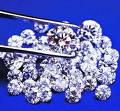Spirits In the Material World
 I am not a materialistic woman, generally, but I love jewelry. Love it. Love earrings, love bracelets, love nose rings, love necklaces. Love sparkly bits and shiny objects. Love the fire, love the passion, love the permanence. Love the craftmanship, the intricacies of design. Love seeing something I've never seen before. Jewelry? I love it - until we talk about conflict diamonds. Then I'm happy to put through six little gold posts, string something pewter on a black silk cord, wrap ten black rubber bands around my wrist and wear a VCR gasket as a ring. For now, sometimes that's the best a gal can do, but not for long.
I am not a materialistic woman, generally, but I love jewelry. Love it. Love earrings, love bracelets, love nose rings, love necklaces. Love sparkly bits and shiny objects. Love the fire, love the passion, love the permanence. Love the craftmanship, the intricacies of design. Love seeing something I've never seen before. Jewelry? I love it - until we talk about conflict diamonds. Then I'm happy to put through six little gold posts, string something pewter on a black silk cord, wrap ten black rubber bands around my wrist and wear a VCR gasket as a ring. For now, sometimes that's the best a gal can do, but not for long.THE Gemological Institute of America has just become a girl's best friend. The venerable industry authority, best known for promulgating the four Cs of diamond judging - color, clarity, cut and carat - has ended its long-standing practice of grading only natural diamonds. This month, over the objections of the powerful diamond mining lobby, it began rating gemstones created in a lab.
Laboratory diamonds, even though they're labeled by the Carlsbad-based institute as synthetic, are not to be confused with cubic zirconia or other shopping-channel substitutes. That would be like comparing lentil loaf to chicken. Manufactured diamonds are molecularly identical to the ones extracted from the Earth.
Am I purring? I believe I may be.
The emergence of technology that can create diamonds sometimes superior to mined ones poses yet another challenge to an industry already combating an image problem. Heightened awareness about the role of diamonds in funding African civil wars in the late 1990s created a backlash, and the movie "Blood Diamond" brought more attention to the issue. The industry has been working overtime to reassure consumers averse to "conflict diamonds" that procedures have changed; now most diamonds are certified as "conflict free."
The industry's latest battle, over terminology, is being fought with the non-mined competition. The synthetic diamond industry wants to market its gems as "cultured diamonds," hoping to gain wider acceptance. The diamond establishment, mindful that cultured pearls destroyed the natural pearl industry, has filed complaints with the Federal Trade Commission seeking to prohibit the use of the term. The FTC will post its decision on its website, though it has set no deadline.
The Gemological Institute, however, is not taking sides. One kind of diamond is a geological (and marketing) wonder, the other a triumph of human ingenuity. Either way, whether it's lab-grown, synthetic, natural or mined, the old saw still rings true: a piece of heated and pressurized carbon lasts forever.
Yes. Yes, it does. I look forward to feeling bejeweled and unconflicted.



0 Comments:
Post a Comment
<< Home